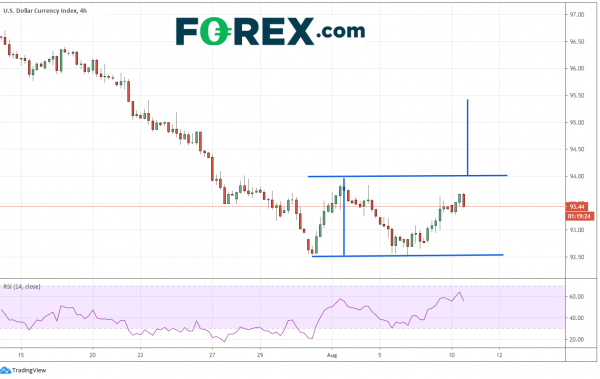AUD/USD has had a strong run since mid-March, trading from .5701 to .7243. The Reserve Bank of Australia (RBA) stated at their last meeting that given the recent outbreaks of the coronavirus and localized shutdowns, current monetary policy was still necessary (interest rates at 0.25%) and that rates would remain at current levels until inflation is sustainable within the 2% to 3% target. In addition, they would begin buying bonds again (they haven’t done so since May) as they try and target the yield on the 3-year bonds, which had risen as of late.
Australia releases their Employment Change for July on Thursday. Expectations are for 40,000 after adding 210,000 in June. Recall however that -38,100 of those jobs were full time, which means 248,000 were part time jobs! Yet, given the coronavirus situation in the US and its affect of the US Dollar, AUD/USD has remained bid.
As we have been discussing recently, the US Dollar has been in a freefall. The coronavirus in the US has been getting worse rather than better, which is signaling to US Dollar Index (DXY) traders that a slowdown in the economy (after the recent rebound) may be ahead. At the most recent Fed Interest rate meeting, the Fed said that the path of the coronavirus would drive monetary policy. They stated the key interest rate will remain at 0%-0.25% until they achieved its maximum employment and inflation goals.
The US released Nonfarm payrolls last week. The US added 1,763,000 jobs to the economy in July vs 1,600,000 expected. Although the number was better than expected, it is nowhere near the 4,791,000 jobs created in June. US initial jobless claims have been steady near 1,400,000 per week, indicating a further slowdown in new job creation may be ahead.
As the coronavirus continues to dominate the US, it became obvious new fiscal measures were needed when emergency jobless insurance expired on July 31st. After Republicans and Democrats could not reach a solution last week, President Trump signed Executive Orders over the weekend. In summary, there would be a deferral of payroll taxes for people making under $100,000 until the end of the year and emergency jobless benefits would be extended at $300 per week rather than the previous $600 per week. Also, the ban on some evictions and foreclosures would continue.
On a 240-minute timeframe, after the DXY formed support and a *potential* double bottom near 92.50, DXY bounced. A break above 94.00 would confirm the double bottom and indicate a target near 95.50.
Source: Tradingview, Forex.com
Also, on a 240-minute chart, after the AUD/USD reached the 161% Fibonacci extension from the highs of June 11th to the lows June 15th near .7243, the pair pulled back slightly. This was the highest level since February 2019. It was no surprise to see AUD/USD pull back as the RSI was diverging from price and the DXY was bouncing. Horizontal resistance crosses near .7200, then the previous highs at .7244. Support is at Monday’s (current) lows near .7140, then near prior resistance and previous lows at .7064. There is also the psychological round number support near .7000.
Source: Tradingview, Forex.com
There are a few specific events that could cause volatility in AUD/USD this week. First is the coronavirus. An increase in cases in Australia or the US could push that country’s currency lower. In addition, if there is continued fallout over the fiscal package in the US, this could move the pair. Finally, in Australia, if the jobs number is better than expected and the recent outbreak of coronavirus cases had little effect on job creation, AUD/USD could move higher.


 Signal2forex.com - Best Forex robots and signals
Signal2forex.com - Best Forex robots and signals




